Do you love beach volleyball but live in an area that has a long
Can you actually play beach volleyball, also called sand volleyball, indoors? The answer in today’s world is YES, indoor sand volleyball courts are becoming more and more common. You may have to do some research to find the right spot, but chances are, there’s an indoor sand volleyball facility closer to you than you would guess.
Indoor Beach Volleyball Facilities
It’s been a gradual increase because the expense is pretty huge and the investment into building something so unique will be difficult until it’s been done many many times. But there are in fact indoor beach volleyball facilities opening up around the United States.
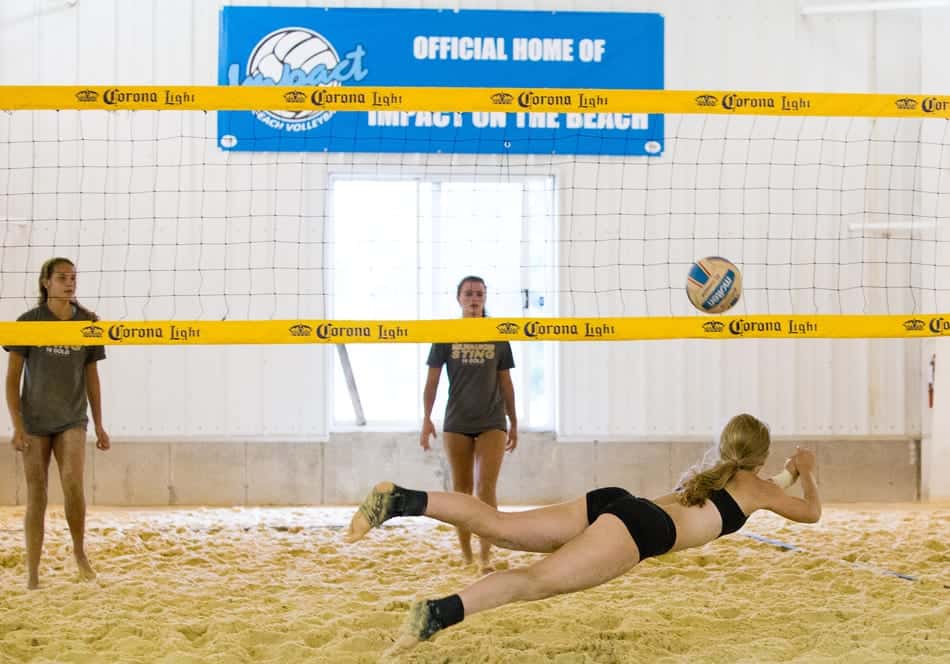
One article put the number at 15 facilities back in July of 2018, you can read about it in this article here.
As NCAA sports programs have added beach volleyball teams to their athletic departments, they’ve had to build practice and competition facilities to support that choice. As the years progress, no doubt more and more of these schools will seek to give their teams the edge by building indoor sand courts.
Some of the examples like the one in the above article are already private companies, where you can join as a member or visit and play occasionally. The closest one I can find to my location is a couple of hours away. I’m tempted to take my family and go play sometime, just for the experience.
Differences In Beach Volleyball and Indoor Volleyball
While the basics of the game are very similar regardless of the surface you’re playing on, there are some major differences.
Court Dimensions In Beach Volleyball
A beach volleyball court is 8 m X 16 m (26.2 ft X 52.5 ft) which is slightly smaller than the indoor volleyball version. So the beach court is 2 squares of 8 m X 8 m. In contrast, the indoor court is 2 squares of 9 m X 9 m.
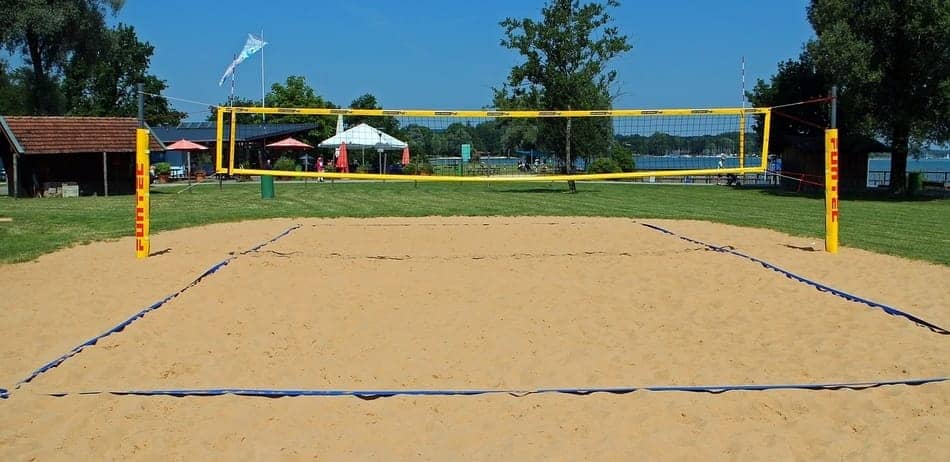
The main reason the court is reduced in size is that you’re only playing with 2 player teams or in some cases 4 on 4. Covering the larger area makes it simply a game of placing the ball where your opponent is not and far too easy to score.
The secondary reason is that your movement is slower in the sand. Even the most experienced beach players are slower on sand than on a firm surface, so reducing the size of the court makes the game more competitive.
Number Of Players On A Beach Volleyball Team
Most of beach volleyball is played on 2 player teams. This requires a much more diverse set of skills because each of you have to be able to do everything decently well. If your team is very unbalanced, your opponents will pick your team apart easily.
While it can be intimidating to think you make up half the team, it can be so exciting too! When you play sand volleyball, you are engaged all of the time. When you play on an indoor team you may go many points without getting in on the action. That’s nearly impossible in beach volleyball.
So a major difference is there aren’t other players to substitute in either. It’s you and your partner who will win or lose this game. Whoever the 2 names are on the score sheet, those are the only players allowed to compete for your team, plain and simple.
Coaching is reduced (at least in international play) to a minimum. Coaches are not allowed to coach during the actual game.
Scoring In Beach Volleyball
To win the set in beach volleyball the score goes to 21 points instead of 25. Beach volleyball also operates with a “win by 2” rule. The tie-breaker set, like the indoor game, only goes to 15 points.
With indoor volleyball, the match can be best of 3 sets or best of 5. With beach volleyball, it is always best of 3.
Switching Sides On The Sand
In beach volleyball, you switch sides much more frequently. Every 7 points during the first 2 sets and every 5 points during the 3rd set you and your opponents switch sides.
This is done to keep the changing outdoor conditions as even as possible. By switching frequently neither team should end up with a huge advantage one way or another.
Can You Set In Beach Volleyball?
The rules for beach volleyball are different when it comes to setting because if you were allowed to simply volley the ball over to open spaces on the opponent’s side of the court, the game would be non-competitive.
The rules say that:
1. Any hit that sends the ball in your opponent’s direction except a block and the serve are considered an attack. Consider how different that is than the indoor game. You would never consider a platform pass (a bump) or an open hand finger pass (a volley), an attack. But in the beach game, if you are sending the ball in the direction of your opponents, it’s considered an attack.
2. An attack hit is considered completed as soon as the ball crosses the vertical plane of the net.
3. It is a fault in beach volleyball, to complete “an attack-hit using an open-handed finger action”. [FIVB Beach Volleyball Rules 2017-2020, Rule 13.2.3]
So if you add all these up, the result is that yes, you may set your teammate with a volley, but if your volley goes over the net before your teammate can hit it, you automatically lose the point.
For this reason, many beach players develop very strong bump setting technique so they can use that any time they want to set very close to the net.
Beach Volleyball Clothing Rules
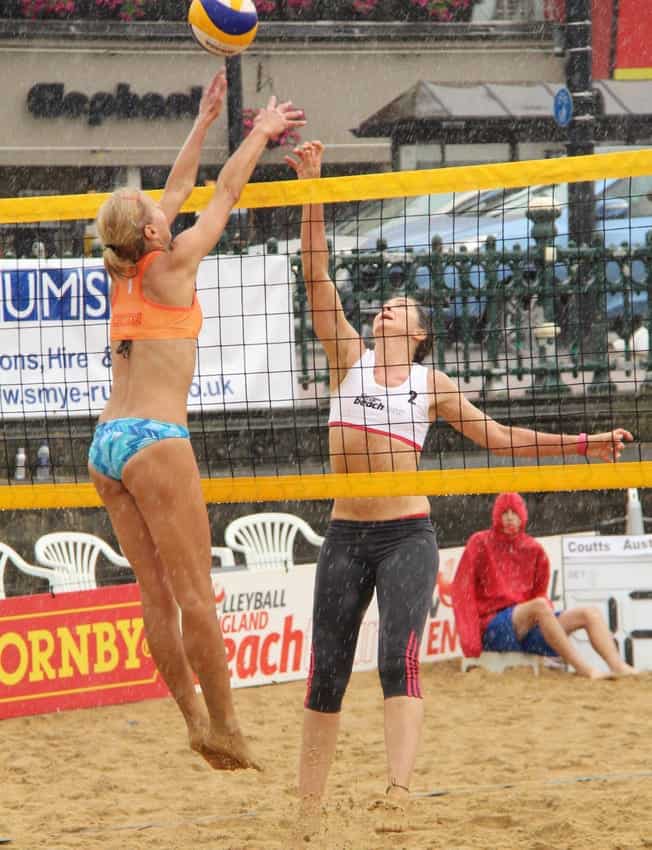
Your league may have different guidelines, but the FIVB rules indicate that a player’s uniform will be shorts or a bathing suit. The team should have uniforms that match in color. A jersey or “tank-top” is optional.
Your jersey (or shorts if no jersey is worn) will be numbered 1 and 2. The number must be on the chest of the jersey or the front of the shorts.
Players may request permission from the first referee to wear an undershirt or training pants under their uniforms.
Players may wear glasses or sunglasses at their own risk. A hat or head covering is optional as well. These can be very helpful to aid with visibility in the sun.
Compression pads are allowed to be worn to help prevent injury.
Similarities Between Indoor Volleyball And Beach Volleyball
Although these 2 versions of the game have some very visible and tangible differences, there are really a ton of similarities. Here are a few:
Net Height In Volleyball
The standard height of the net in beach volleyball for men is 2.43 m (7’ 11 ⅝”) and for women is 2.24 m (7’ 4 ⅛”). Although it may feel that the net is a different height, this is probably just due to the fact that it’s more difficult to jump on the sand. With practicing good technique, you’ll be able to learn to compete at the net just as competitively as the players you’re facing.
Rally Scoring
Both the indoor game and sand volleyball use a rally point scoring system which keeps the game fast-paced and every rally is meaningful. This makes the games exciting and entertaining for fans.
To learn all about rally scoring, check out our post about it called Rally Scoring In Volleyball Explained.
The Core Principles Of Volleyball
At its core, volleyball is a game of teamwork, intensity, and executing a variety of skills, and strategy. This remains the same regardless of the surface it’s played on.
Both the beach game and the indoor version are highly demanding physically and are a great sport for a wide variety of people and age groups. Volleyball can be learned by the young and old and enjoyed at all different levels of skill.
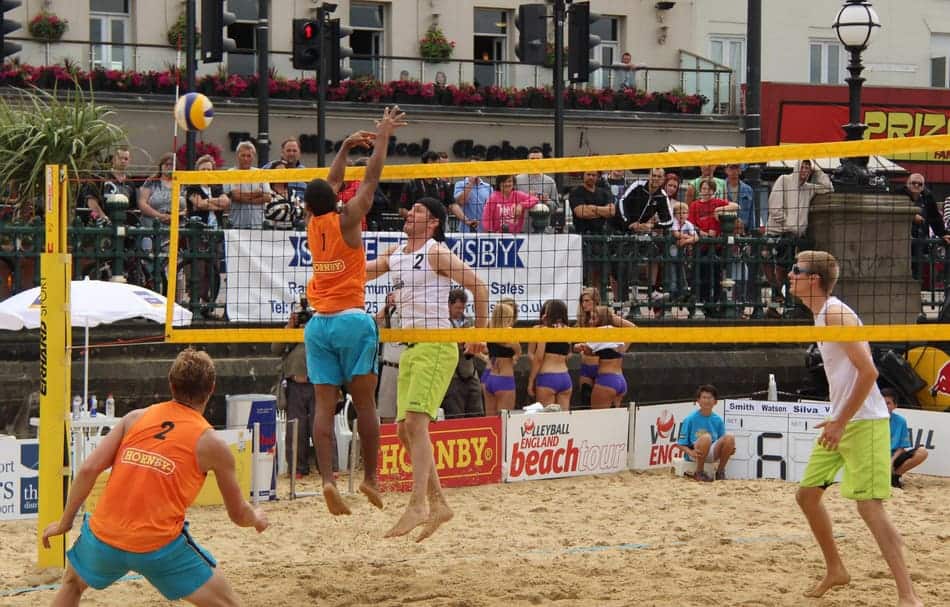
It’s a game of ever transitioning between defense and offense. In many sports, there are prolonged periods of offense or defense and breaks and line changes in between. In volleyball, this happens frequently, between individual hits continually throughout the rally.
Both versions of volleyball are a game of motion. Both teams are working to keep the ball in play, keeping it in flight. Yet both are also trying to end the rally at the other team’s expense.
Benefits Of Cross-Training Between Beach And Indoor Volleyball
Over the years it has become more and more common for players to spend time crossing from one version of the game to the other. This isn’t just for players who are deciding to permanently switch their focus, but also for cross-training.
When you cross-train you typically are playing a different sport completely and benefitting from some overlapping athletic skills and challenges. You’re trying to develop your primary sport’s skills through similar actions and training in a second sport.
In choosing to cross-train between beach and indoor volleyball, you’re picking sports that are so closely aligned, many of the skills in one translate almost completely to the other. Although there are differences, so many of the skills lend one to another.
If you improve your serving in beach volleyball, won’t that help you when you take your serving back indoors? If you work on your blocking indoors, won’t that help you when you move back out to the sand?
By changing the scenery you can keep the sport fresh and challenging and push yourself in very healthy ways.
Is Beach Volleyball Harder Than Indoor Volleyball?
The question comes up, “Which is harder?” and there’s not really just one answer. It depends on your particular skill set. Are you an excellent player in one field or the other already?
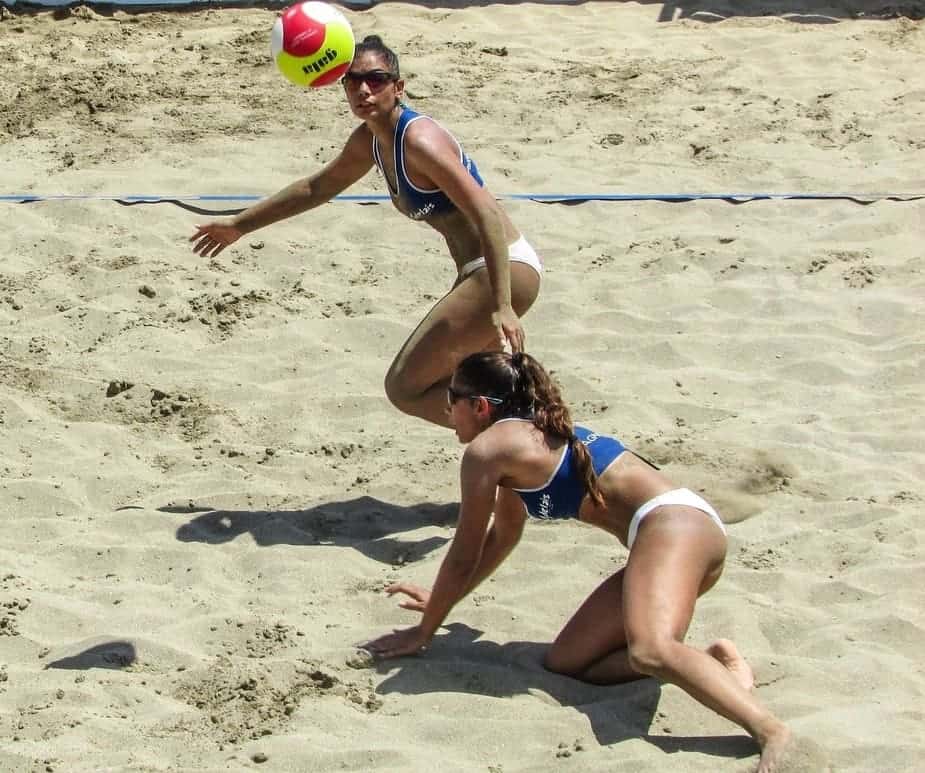
The general rule is indoor volleyball is a game of specialization and beach volleyball is a game of well-roundedness.
What I mean is, to be truly great at beach volleyball, you have to be pretty fantastic at…everything. You need to be solid at every skill and exceptional at several.
In indoor volleyball, you can be amazing at one particular position, let’s say playing middle blocker, and really just focus on a few skills that serve that role. It really doesn’t matter that you may have a terrible serve, because your libero can serve for you. Or it may hardly ever matter that your setting is weak because you’re about the last option on the team to set the ball.
The truth is, the games are just different, and which one is harder? That comes down to your skillset.
To go deeper in exploring the switch between indoor and beach volleyball, check out our article called Should I Switch From Indoor to Beach Volleyball?
Is Beach Volleyball A Better Workout, Will I Burn More Calories?
Beach volleyball truly is a better workout and you will burn more calories most of the time. If you really think about it, this becomes obvious for a few reasons:
1. You’re playing on a team of 2, not 6. More action = more calories being burned.
2. You’re moving in sand. That shifting surface drains your energy and requires more to move.
3. The environment is not controlled and the elements will require your body to compensate in the form of energy.
- Hot blazing sun? Your body must produce sweat to cool off = energy.
- Drizzly cold weather? Your body has to heat up to keep you warm.
I don’t think weight loss is a primary driver in choosing which version of volleyball to play for most people. We tend to just play the form that’s the most convenient or fun. But to answer the question, yes beach volleyball should always be a better workout if you’re doing it right.
Benefits Of Playing In An Indoor Facility
Although this may seem obvious, there are several benefits to having an indoor facility for your sand volleyball training and playing.
Consistent Weather
How wonderful would it be, walk outside on a very windy or even stormy day, and know that you’re going to play on the sand today with your friends? You can have just as much confidence that you’ll enjoy your time as if you were going to do any other indoor activity.
The sun can be a very enjoyable part of playing beach volleyball, but it can also be a limiting factor. Some of us aren’t used to spending long hours in the blazing sun on a hot summer day. Being able to step indoors in the peak of summertime would be a nice change.
We have such a hard time knowing what the weather will do very far ahead of time. Rain can ruin your plans with hardly any warning. You almost can’t count on playing on the sand until you wake up and see how it looks in the morning.
The overall temperature is limiting for months out of the year for most of the country. We can’t all live in Florida and California. I know here in Alabama, we go months with cool to cold overcast weather that just isn’t inviting you outside.
Having a nearby indoor sand volleyball facility would hurdle all of these obstacles. I can definitely see a huge and growing interest in developing these kinds of activity centers in the future.
Consistent Lighting
Although we’ve already touched on that the sun can be a factor outdoors that you can take away indoors, there’s another important angle to this. When you have an indoor facility, you can turn the lights on and off 24 hours/day.
Your team can practice or play without being at the mercy of whatever lighting is available at your local outdoor courts. Some outdoor courts have fantastic lighting at night but others have none.
Others have lighting, but only until a certain time. By having access to an indoor facility, that’s just a factor that’s completely under control.
Consistent Maintenance
Where you play on outdoor sand courts, how often does it get some TLC (tender loving care)? Is the sand raked and cleaned up after each match? Is the net patched whenever it gets damaged?
When you attend an indoor sand facility, you know there’s a level of maintenance that’s going to automatically be present that’s just hard to expect in the typical outdoor scene.
Predictable Availability
When you go to the beach or park and play on the sand, is there a way to guarantee your reservation? Some places do have an organization tracking who plays and at what times. You may have to pay to play.
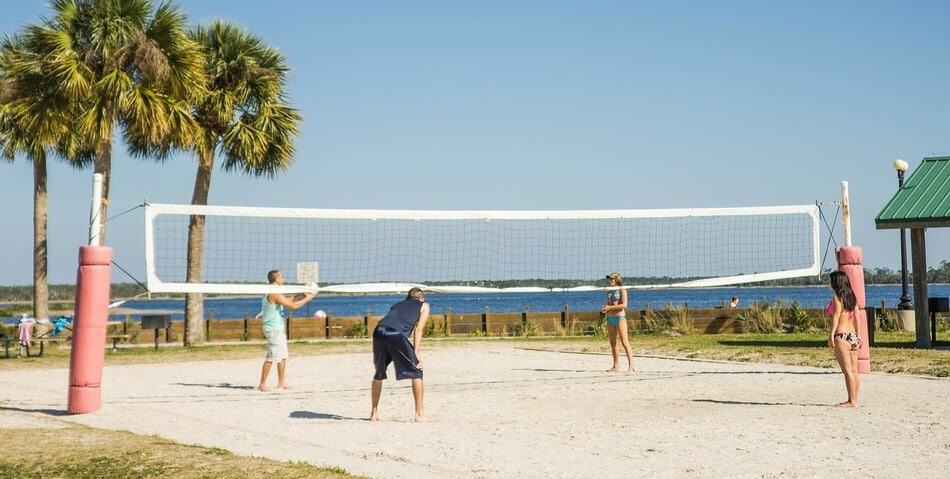
But many of our sand courts are a free-for-all and you never know for sure if you can get a game in until you arrive. While we may meet and make some new acquaintances and form volleyball friendships through these situations, it’s hard to count on predictability.
You may have the option to join in and play a 4 on 4 or even a 6 on 6, and if you would rather not, well, you may just not be playing today.
All in all, I’m excited about the rise in popularity of the beach volleyball version of our sport. I think it’s fantastic that it is spreading through the college and high school scene with new schools adding it each year.
Over the next decade or two, I expect there to be an increasing influx of these indoor sand volleyball courts and I for one, can’t wait!
Related Questions
Do You Wear Shoes For Beach Volleyball?
Most players choose to play barefoot and enjoy the experience. The rules allow for players to wear sand socks or shoes with the referee’s approval. Of course, if you’re playing a recreational game, you can choose to wear whatever you like.
Can Playing Volleyball Help You Lose Weight?
This is a very common question that comes up to people that are interested in volleyball but haven’t been very active in the sport. The answer is that volleyball is not guaranteed to make you lose weight, but it’s a great sport to help contribute to a weight loss plan.
If this is your goal, playing on sand will be much more effective at burning those calories. For a more in-depth answer to this question, I found a really helpful resource on another site, check out this article.
Photo credits:
Feature image by mastermind76 from Pixabay
Indoor beach volleyball image by popo.uw23 on flickr.com: https://creativecommons.org/publicdomain/zero/1.0/
Sand court image by Manfred Antranias Zimmer from Pixabay
Clothing image Funk Dooby on flickr.com: https://creativecommons.org/licenses/by-sa/2.0/, cropped.
Men’s beach orange vs. white team image by Funk Dooby on flickr.com: https://creativecommons.org/licenses/by-sa/2.0/, cropped.
Women’s blue and white image by Dimitris Vetsikas from Pixabay
Beach court scene by Michelle Maria from Pixabay
Recent Posts
Athletes, listen up! Do you have a closet full of old jerseys, sweatpants, and tees that you just can't seem to part with? Well, dust them off, because you're sitting on a goldmine of fashion...
You may have heard, or you may have noticed, that there's been a change to the rule about double contact in volleyball. In 2022, an experimental rule change began to be implemented, where the double...
